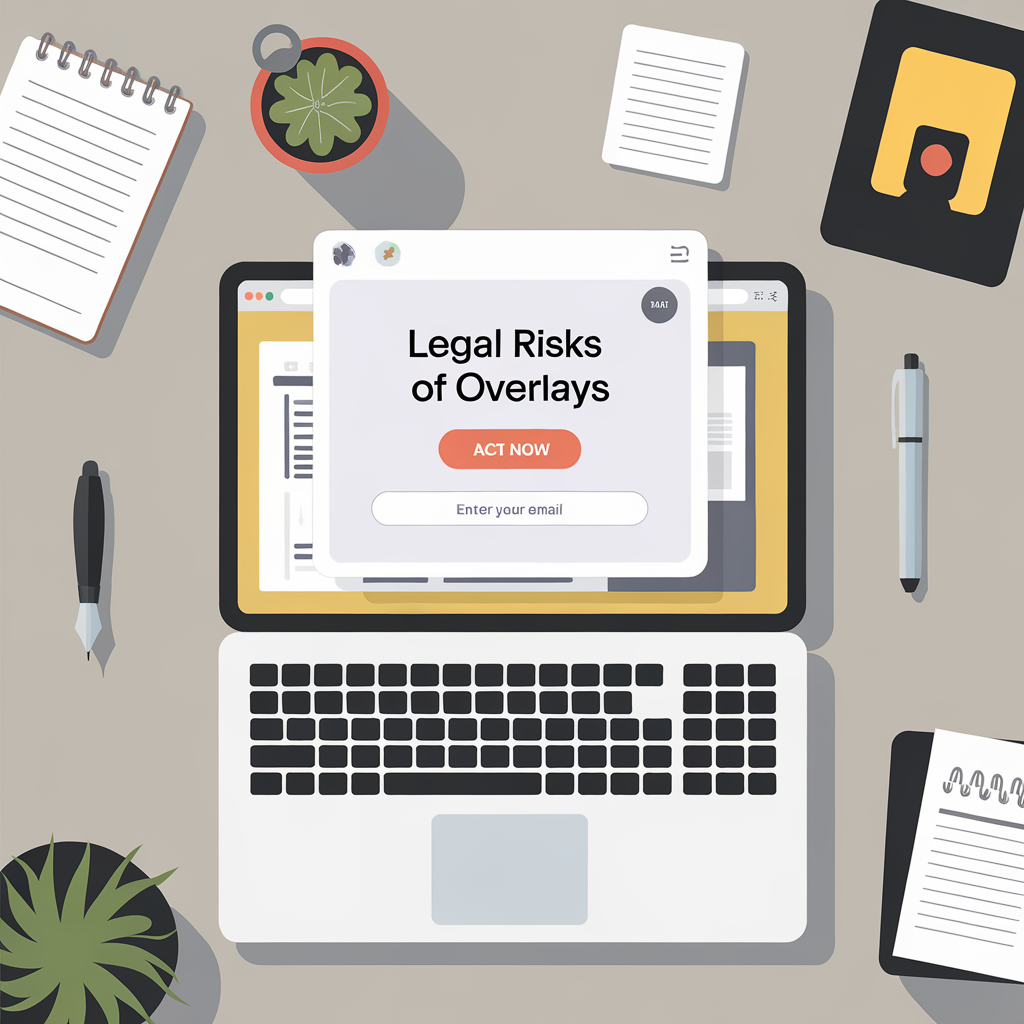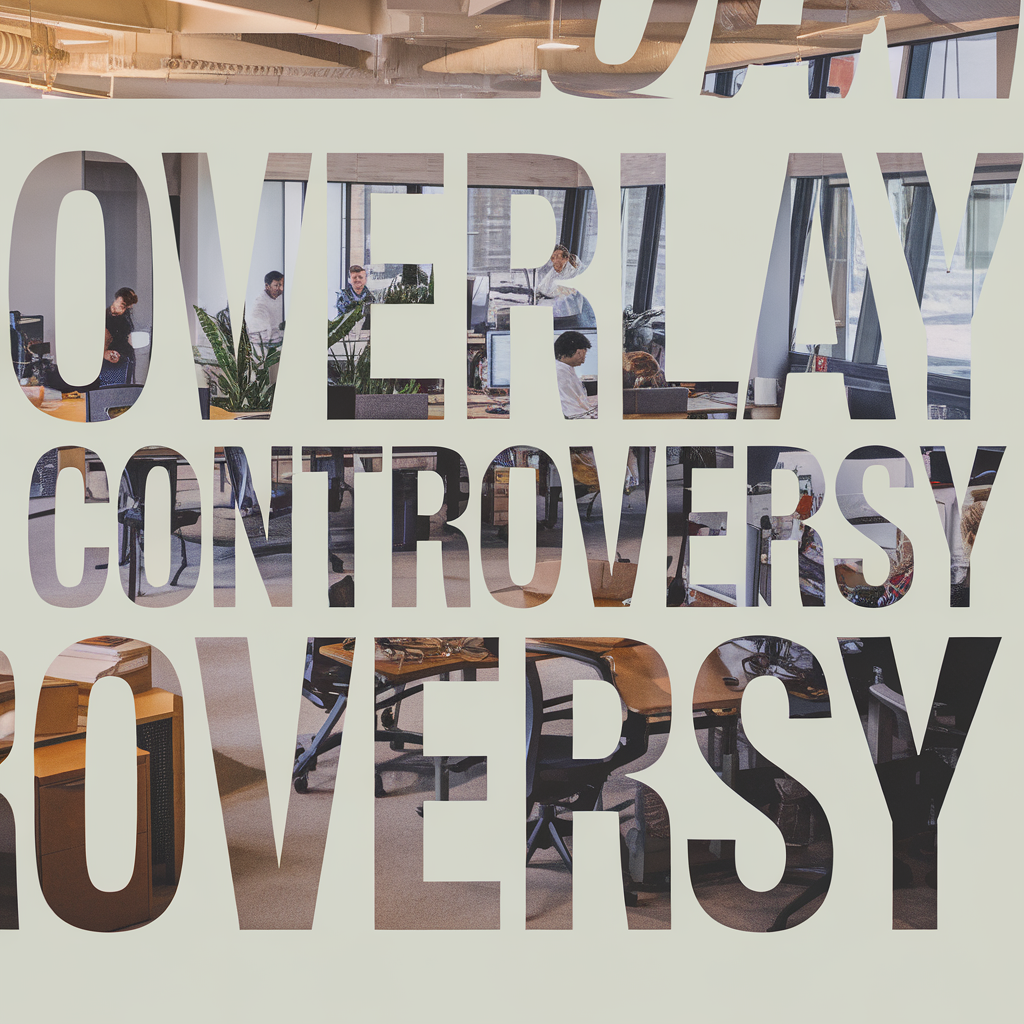Ahoy there, risk-taker! We bet you're tip-toeing on that fine line of innovation and uncertainty, juggling the contemporary appeal of web overlays while swallowing down those jittering concerns about their legal risks—ah, the adventure of entrepreneurship. Now, why weather this storm alone when we could ride the waves together?
We’re not just tossing you a lifebuoy here; we're also highlighting a navigational map to chart your course to safer waters–all based on a case study brimming with tested insights and hard facts around the 'legal risks of overlays.' You’re looking for genuine lessons learned from the battleground, strategies weighed and shaken by challenge tests, results etched in reality—not just theoretical musings. We get it.
This case study unfolds that journey—barriers met, strategies implemented, results examined—without deviating from our core values of transparency and openness. You're in for a wild ride that swings between exhilarating breakthroughs, bruising mistakes, and quite a bit of wise wit. Hey, who said explorations had to be bland?
So, buckle up as we don our analytical hats and translate data-speak into reliable lessons and actionable recommendations – because at the end of this thrilling ride, every entrepreneur should feel empowered to make informed decisions amidst the swirling mists of overlay legality.
And remember, just like a thrilling page-turner, take your time savouring each chapter – overviewing legal risks, detecting challenges, recognize effective strategies, analyzing real-world results, learning key takeaways and the final round-up with basic recommendations. Why not give this a whirl? Dive in…and let’s navigate these uncharted waters together, shall we?
Overview of Legal Risks of Overlays
Picture this: you're an entrepreneur diving into the exciting world of technology. You've come up with a brilliant solution—a software overlay—that would work wonders for your product offering. But, hold on–did we take a detour from the adventure of innovation and stumble onto the rocky terrain of potential legal repercussions? Sorry to burst your bubble, my friend, but when we talk about overlays in technology, we cannot ignore the 'legal risks of overlays'. It's not exactly the jazziest part of the ride, but it's certainly crucial.
Let me guide you through a real-world instance, a predicament that nearly sent tech giant ABC-XYZ wrestling through court labyrinths. Implementing software overlays, ABC-XYZ aimed to sequentially improve the functionality of their products. However, in their bid to ace usability, they underestimated the accessibility challenges laid out by web content accessibility guidelines (WCAG). Lawsuits flew in like uninvited party crashers which not only drained resources but also blemished their stellar reputation.
Unexpected, isn't it? An overlay, meant to augment UX design, ended up attracting lawsuits due to accessibility challenges! Analogous to being invited to a party, only to find out you're allergic to the cocktails served.
So, hang tight and fasten your seatbelts as we further explore the complexities and potential pitfalls of employing overlays—navigating legal risks is like threading the needle, and it never hurts to understand more about what you could be getting yourself into—or should we say, threaded into. After all, who wants to down a cocktail you're allergic to? It's all about blending innovation and regulation to create a delightful-user experience that respects legal norms. It's high time we dive deeper into the tale of ABC-XYZ's woes—it might just save you from an unplanned trip on legality lane!
Identifying Common Challenges
Expanding on our previous discussion, let’s dive into a hypothetical scenario. Imagine this: you’re a tech-savvy entrepreneur just embarking on a promising online venture. You incorporate overlays to your company website, expecting them to increase customer engagement and boost your conversion rates.
However, your joy is short-lived when you suddenly face the harsh reality of legal risks of overlays. Lulled into believing that every software update is a treasure trove for improving accessibility, you push aside the critical issues of usability. Awfully naive? I agree. But let's face it – we've all been caught up in the excitement of something seemingly revolutionary at times.
Compared to the ugly beast that legal complaints can morph into, an overlay running amok seems like cupcakes for breakfast, doesn't it? Landing amidst a gadzillion limitations including inaccurate tools or incorrect labels can seriously threaten your reputation and customer relationship. Plus, there's always the underestimated threat of accessibility lawsuits knocking on your door. Worst case scenario—you end up playing catch with a hot potato named 'Legal Penalties’.
Insidious, right? But what if there’s a brilliant alcove on this dangerous cliff? Being aware of the legal risks of overlays early in the game could help navigate around this intimidating terrain. If you proactively find and address accessibility or usability issues, then you might be able to turn these stumbling blocks into stepping stones.
Trust me, adopting proactivity paves the way forward more than any technological advances ever could. Let this example act as a sober awakening—we must learn to rise above our challenges while remaining transparent and open with our clients for sustainable growth in this digital age. Why not give futuristic technology trials a whirl? But don’t forget to brace yourself for unexpected hiccups along the way.
Implementing Effective Strategies
Diving right in, let's explore a relatable example to anchor our observations. Picture yourself as a go-getting entrepreneur who's come up with a killer app idea. You want to ensure you avoid the notorious legal risks of overlays. So, introducing accessibility overlays seemed like a no-brainer—you cover all the user experience bases while keeping your legal team singing in harmony, right? Well, not so fast!
Meet Amelia. She’s an entrepreneur much like you and decided to implement some snazzy accessibility overlays on her new networking app. The result? She thought her team could kick back, sip lattes, and celebrate ticking off the accessibility checkbox. But six agonizing months later, they found themselves stomaching countless late-night meetings, tensed and tadalafil-faced over a mounting pile of lawsuits.
Why was Amelia bowled over by these unforeseen legal hiccups? It turns out, those shiny hubris-driven overlays didn't quite default their accessibility rank sky-high, as she imagined. She got slapped with a hefty dose of reality, including a gamut of unforeseen ADA lawsuits that caused more trouble than those overlays were worth. In fact, while these overlays promised inviting convenience, they ended up being more of annoying hassle to wheelchair-bound users and visually impaired folk.
Now, you must be wondering, what exactly happened? Could this disastrous outcome have been avoided? Well, fear not! We’ve scouted the horizon for possible solutions and found some promising practices to help you navigate these choppy waters—practices akin to an entrepreneurial life jacket!
In Amelia’s case, she should’ve focused on implementing real adaptive tech instead of quick-fix overlays—that way none of her users were left stranded at the signage of her app. Moral of the story? Don’t use accessibility as a checklist—you’ve got to keep iterating till your creation is not only pra
Following Amelia's downfall is an essential reminder to entrepreneurs of the notion of transparency and openness. Overlays might seem like an easy way out, but when your enterprising eyes are on long-term growth, it’s best not to compromise at accessibility. In this chase for glory, remember the adage: all that glitters isn't feasible wholesomeness!
So, why not give the process-centric approach a whirl? The only way to address legal risks of overlays is by taking conscious decisions. Decisions that take into account the real-world impact on your diverse, vivacious user base. So dear entrepreneuring friend, choose wisely; navigate away from the rocky cliffs of surface-level appeal and sail towards the steady terrain of responsible tech. Go beyond overlays in attacking your app's accessibility challenges, thereby deducing to fewer unforeseen lawsuits—effortlessly turning you into the embodiment of responsible success. Sure sounds sweet, doesn't it?
Analyzing Results and Outcomes
Moving forward in our journey, let's unpack a case analysis where the legal risks of overlays became all too real. Imagine you're a thriving online entrepreneur—but with abundance comes responsibility, right?
Like most entrepreneurs, you've integrated an overlay designed to boost accessibility. However, this one-size-fits-all solution began creating usability issues, leading to a flurry of worrisome accessibility grievances. Now the name of your business buzzes with impending litigation. Panic attack worthy, we know!
Ensuring transparency and openness, you hired a dedicated team aiming to rectify these prevailing issues. They removed the offending overlays, worked tirelessly on website modifications, closely adhered to legal fronts, and championed accessible design as an integral business goal.
Result? You emerged victorious from this frenzied ordeal—accessibility complaints genuinely handled, disastrous litigations dodged, technology learned. Cheers, entrepreneur—we bet you nearly emptied your sweat glands!
Switching gears to your cousin Larry's online start-up, we see an entirely different result. Larry employed multiple overlay prototypes without a serious thought about accessibility or any potential legal risks of overlays. We encourage you to learn from Larry. In the world of overlays and in life in general, proactive is always better than reactive. You don't want to drown because there aren't enough life vests when the UX Titanic starts going under.
So why not give gratitude a whirl for these real-world hiccups teaching vital lessons? We've tread tricky terrains of technology, faced intimidating challenges and paved ways towards exciting new frontiers of success. Deep inhalation and press forward—we continue carrying these lessons with us into the future of digital entrepreneurship adventures. Diving headfirst into unprecedented risks proved fruitful—you're not just surviving but absolutely smashing it!
Key Lessons Learned from the Case Study

Building on our exploration of the weighty implications of technology use, let's take a dive into understanding the colossal impact of the legal risks of overlays in technologically-driven entrepreneurial spaces. Imagine running a successful tech startup, beaming over new ideas for improving user experience. You decide to implement what you think would be a game-changing feature: website overlays. They're snazzy, right? You're convinced they'd enhance interactions and put you ahead of competitors.
As your team is coding away, excited by the thought of witnessing the magic come alive, it is crushed by a lawsuit, claiming discrimination against persons with disabilities. Why? Because the overlay rendered your site inaccessible contrary to legislation like the ADA (Americans with Disabilities Act). This is not science fiction, it's as real as it gets.
Apart from damaging brand reputation, you also end up shelling out substantial funds for legal defense and, potentially, settlements. Obvious as it might be, blissful ignorance isn't an ideal entrepreneurial strategy. That's why we're here to help you keep eyes open and dodge these nightmare scenarios.
Reflecting on this illustration helps highlight a major takeaway—the legal risks of overlays cannot be underestimated in satisfying on-site accessibility or usability issues. The presumed solution morphs into an almighty problem itself, plunging your daring hustle into the world of unanticipated litigation. At this juncture, entrepreneurs must weigh the attractiveness and potential benefits against accessibility complications and potential lawsuits—you'd think twice before catching a shiny penny at the edge of the cliff, wouldn't you?
Remember our core values—transparency and openness—adhere to adhering to these principles, you can avoid this perilous journey down unnecessary legal alleyways. The takeaway here? There’s no point in applying a band-aid fix if it opens you up to a whole world of possible legal dilemmas—sounds about as comforting as having your wisdom teeth pulled again, doesn't it? Ensuring accessibility ought to be a foundational premise on which to base every decision affecting your client's usability. So, the next time you think about uplifting your site, you'll be making Double-tap decisions with this in mind. Ready to drive forward? We reckon you are!
Recommendations for Entrepreneurs
So diving right into our key takeaway from afore: you cannot afford to disregard the legal risks of overlays in your tech endeavor. They're like those 'Beware of Shark' signs at a beach—you might love swimming, but it’s worth considering the threat, isn't it? Just picture this—a progressive software startup revamping their UI with attractive overlay features that seemingly solve usability issues but unknowingly violate accessibility norms.
But why take such a risk when we can learn from mistakes and avoid them? Continuing our exploration, the startup was probably thrilled by the overlays' whiz-bang effect on user engagement—until they faced a legal soup over Accessibility Act's violations. Oops!
If you halted at the 'Accessibility Act’, don't worry—it's not as scary as it sounds. Just think of it as a hard-to-ignore house rule in the tech hood. If you ain't seen eye-to-eye with it, brace for a rocky sail.
Now imagine your scaling software startup smacked with noticed accessibility discrepancies, becoming liable for disheartening damages. Flabbergasting, isn’t it? Lessons to be ingested—transparency is paramount, like listened to an aux cord while jamming in a car session; being open about your practices can spare you crippling legal costs.
So how about throwing a peek into those accessibility guidelines again before launching your super-duper overlays? Just the way you double-check your roof fixture before the monsoons—a stitch in time saves nine, remember?
We'd say decelerate your drive back into innovative routes while wearing the hat of an enlightened entrepreneur, balancing core responsibilities, and savvy decision-making that includes ecru shade of accessibility understanding. Keep cruising through the undulating technological revolutionary. Your seemingly insignificant gestures may lift other struggling entrepreneurs trapped in overlay pitfalls. Be that beacon light. Nothing says "Openness" quite like that! So before rushing, take a shot: Assess the legal risks of overlays—it's better to be safe than sorry! By aligning practices to accessibility norms, you don't merely cut the legal cords; you're enriching the user experience for every individual out there. Now that's what we call a dual jackpot!
Conclusion
As we inch closer to the end of this exhilarating rollercoaster ride exploring the legal risks of overlays, let's pause for a moment, shall we? If there's anything our deep-dive should make clear, it's this nugget of truth: when it comes to technology, there's rarely a simple one-size-fits-all solution. Can I get an "Amen"?
Now, the challenges of accessibility and usability we've discussed are more than just pesky speed bumps on the road to success. These are real, everyday battles faced by entrepreneurs like you (and yes, even the likes of Elon Musk and Bill Gates). All sunshine and roses aside, maneuvering these terrains is a Sam vs. Goliath situation. Now, who doesn't love a good underdog victory?
Our case study's strategies aren't merely theoretical ammunition but valuable take-home advice that likes to get its hands dirty in real-world applications. From identifying common pitfalls to implementing alchemical solutions that transform challenges into opportunities—these are tools for your entrepreneurial toolbox. Remember those "aha" moments as you navigated the journey of this case study.
If you walk away with anything from our shared chatter, let it be this: fully digest the lessons carefully curated from this study. See these insights not merely as dots on a page but flashing neon signs guiding you around the bend—and steering you away from potential risks tied to overlays.
Feel like diving deeper into our sea of knowledge? Try taking another lap through similar case studies or applying these strategies to your business ventures. You see, entrepreneurship isn't just about shooting for the stars; it's also about weathering meteor showers. And we believe you have got what it takes to do both!
And remember—we're all in this together. We aren't just loading you with ‘tech talk’; we're inviting you to walk this pied tech-land brimming with promise and potential glitches. Together, we'll navigate each exciting hurdle—you, me, and our ironclad strategies. So why not buckle up, roll up those sleeves and take the leap? After all, the most spectacular views come after the hardest climb—or in our case, the steepest code!
Keep shining, fellow adventurers—the dawn of your entrepreneurial success is nigh. As they say, 'Code today, conquer tomorrow,' or something like that!
Before you venture off, remember this— progress lives in learning, acting, and growing beyond boundaries. Carry with you these lessons learned in understanding, planning, implementing, reforming, and succeeding against the odds.
So why not give this everything you have got and prove that you are indeed your business's ultimate superhero. Let's crush those codes… because the final verdict remains, you've got this!
FAQ:
What are the common legal risks associated with overlays? Overlays often risk infringing on accessibility laws if they fail to properly comply with standards such as the WCAG (Web Content Accessibility Guidelines). They could also lead to copyright issues if they replicate material without express consent. Using third-party overlays might open up negotiations related to user data privacy. Lastly, overlays that interfere with normal website function can be legally challenged for obstructing a business' operations. How can we effectively mitigate these risks? Strategies to mitigate legal risks include ensuring overlays meet accessibility laws; this can involve expertise from web designers and IF-LAW (Internet and Information Law) lawyers. Be meticulous during content repurpose – always obtain necessary permissions or create original content. For third-party overlays, create agreements protecting consumer data. To avoid hindering website functions, test overlays exhaustively before going live. What were some key takeaways from the case study? The study underscored the paramount need for understanding relevant laws guiding overlay use and strict adherence to these laws to avoid legal tussles. Additionally, it affirmed the importance of continuous testing and refinement of overlays for optimal functioning and minimal user disruption. Lastly, respecting copyright laws can not only prevent legal actions but also inspire creativity and originality. Can you provide any specific recommendations for entrepreneurs? Entrepreneurs using overlays should complete legal due diligence to understand their local online regulations. Also, ensure that expertise in these laws is available within your team or network. Always gather required permissions when repurposing content and prioritize consumer data privacy while dealing with third-party overlays. Lastly, ensuring your overlay doesn't negatively affect your website's user experience is a crucial aspect of maintaining an effective online presence.


